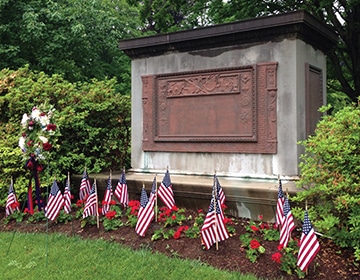Old Ridgefield – The Jacklins
The little known history of an early African American Ridgefield family
by Jack Sanders
››Generations of Ridgefielders have been told how the town was settled by families of European ancestry. However, not much has been taught about the African Americans, free and enslaved, who helped establish and build the fledgling community in the wilderness — among them three pioneering families who contributed a half dozen of their sons to the American Revolution.
Enslaved men, women, and children were living and working in Ridgefield from its earliest settlement, “owned” by prominent families like the Keelers, Scotts, and Seymours. Even the Rev. Jonathan Ingersoll, minister of the Congregational Church from 1739 until 1778, had slaves.
Unlike most other Connecticut communities, Ridgefield’s African American population included those who were free, and they were quite patriotic.
Early Beginnings
The earliest free African American Ridgefielder was probably Michael Dimorat who, in 1736, bought an acre along West Lane on which he built a house. His family included four children, one of whom was John Dimorat, who was born in 1734 and who later served in both the French and Indian War and the American Revolution.
Robert and Samuel Jacklin were sons of a Massachusetts slave who had bought his own freedom in 1711, married a year later, and eventually bought a farm in what is now New Canaan. Robert and his wife, Anne, were among the first settlers of upper Ridgebury (land now part of Danbury). In 1745, they purchased nearly 75 acres of hilly, ancient forest and carved out a farmstead; clearing rocky fields, building a house and barn, and planting crops — a huge undertaking.
They also raised five children including Daniel (born 1749), Ebenezer (1757), and Thaddeus (1761), all of whom volunteered to serve in the Revolution.
Ebenezer, the middle child, joined the Fifth Connecticut Regiment, led  by Ridgefield’s Col. Philip Burr Bradley, fought at Monmouth and was with General Washington at Valley Forge. Like thousands of others in the war, he was stricken by an illness that eventually led to his discharge.
by Ridgefield’s Col. Philip Burr Bradley, fought at Monmouth and was with General Washington at Valley Forge. Like thousands of others in the war, he was stricken by an illness that eventually led to his discharge.
Thaddeus Jacklin served in the Fourth Connecticut Regiment, and Daniel, the eldest, was probably a member of the Fourth Regiment of Ulster County militia in New York. Another Jacklin, Lewis — whose parents have not yet been identified — enlisted from Ridgefield and was a brigade wagoner in the Fifth Connecticut, wintered at Valley Forge, and served three years in the war.
Robert’s brother, the equally industrious Samuel Jacklin, acquired a 50-acre farm in southern Ridgefield and not only raised livestock and crops, but also kept bees, brewed beer, and made his own cheese. Joseph Jacklin, his adopted son, served in the war from Westchester, enlisting in a militia unit in 1777 and 1778.
After the War
After the war, some of these veterans lived in poverty, bareley a step above slavery, working as laborers. As was the fate of many African American veterans who fought for the nation’s independence, they were unappreciated and often destitute.
John Dimorat, for instance, died in 1807 in a Boston almshouse. Ebenezer Jacklin became a hired hand on farms. By 1818, infirm and broke, he sought out — and got — a newly-enacted federal soldiers’ pension, aimed at the needy, which helped him until his death in 1824.
Only Lewis and Ebenezer Jacklin have gained any Ridgefield recognition for their service: Both are listed on the Veterans Monument on Main Street.
Another African American veteran with ties to Ridgefield fared better than many. Samuel Jacklin’s daughter, Elisabeth, married a Redding man who had been enslaved—Jack Freeman—who selected that name when he was emancipated as a reward for his serving in the Revolution with the Fifth Connecticut. He and Elisabeth eventually bought a Redding spread from his former masters and became well-known and respected farmers.
However, like all African Americans who risked their lives in the fight for America’s political freedom, Jack Freeman was never considered a full citizen. By state law these men were banned from voting or holding office. He fought taxation without representation and wound up spending much of his life taxed and unrepresented.
This area is known for its rich history and that is part of what makes it stand out. While the Battle of Ridgefield during the Revolutionary War may be in the mind of most Ridgefielders, as Black History Month approaches it’s important to also reflect on everyone who has contributed to the unique energy of this Cultural District. •